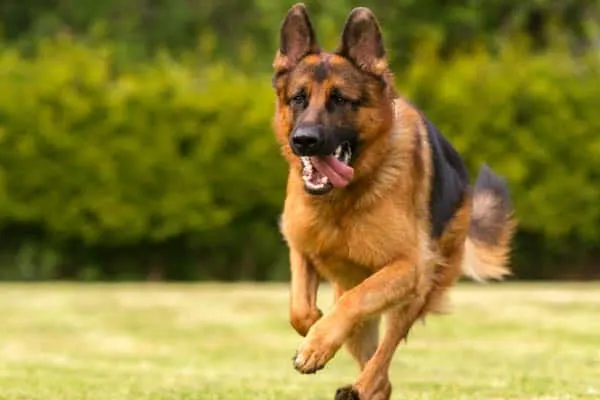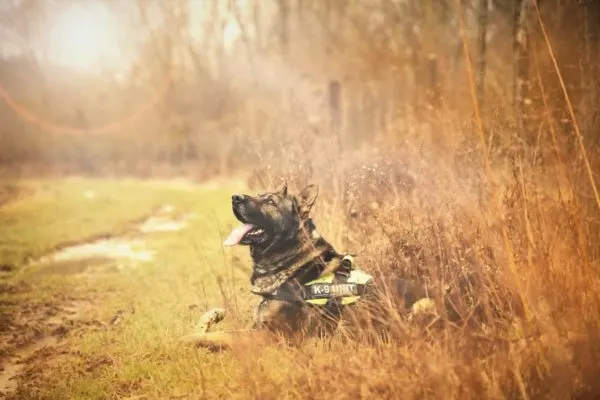How Big Can Your German Shepherd Dog Get? Bigger Than You Think!
Getting a puppy is always an exciting time. Much like a newborn baby, you put a lot of planning into making a comfortable home for your new addition.
Unlike infants, however, you often have to ponder how big your dog will become and how much room she will ultimately need.
Different breeds vary greatly in size, and if you have never owned a German Shepherd, for example, you may be only guessing about how much space she needs.

How big do German Shepherds get?
German Shepherds typically range between 22 to 26 inches tall and 60 to 85 pounds in weight.
However, do you ever wonder why Shepherds are of a particular size? What about the breed standard, and what if you want to show your dog?
Maybe you have an Alsatian mix, and you want to know how much the Shepherd side will influence her size.
The original influencers of size in the German Shepherd
All German Shepherds can trace their ancestry to three groups of dogs prevalent during the 1800s.
Thuringian Shepherd Lines
Max von Stephanitz, as you probably know, finished the work the Phylax Society began to standardize the German Shepherd breed.
The Shepherd he chose as the breed’s foundation sire, and the first official German Shepherd Dog was Horand von Grafrath, a Thuringian Shepherd.
Horand was formerly called Hektor before Stephanitz acquired him.
Thuringian Shepherds originally found use as carriage and horse stable guard dogs. Although occasionally referred to as yard dogs, Horand von Grafrath was both a sheepherder and a show champion.
People familiar with him said he showed interest as well as an affinity for tending flocks.
Of note was the Thuringian Shepherd’s rather small stature. Horand was 24 inches tall and quite large for his type.
Despite von Stephanitz’s proclaimed goal of finding the ultimate working dog, Hektor’s wolf-like colors, upright ears, wolf-like expression, and bearing played a large role in his selection.
Hektor’s lasting legacy to his offspring was high energy, and a signature looks more so than his size.

Wurtemberg Sheep Dogs
Wurtemberg Sheep Dogs brought moderation and stability to the Thuringian bloodlines.
Where Thuringian dogs were ruthless and indiscriminate attackers needing little provocation, Wurtemberg dogs were deliberate.
However, their greatest attraction was perhaps their larger size and more substantial bone.
With size came appealing traits like courage, mental stability, and trainability. The Wurtemberger Sheep Dogs also had impressive gaits and the attractive tail set that modern show dogs still display.
Wurtemberger regional dogs would develop the German Shepherd as a trotting worker.
This is an average-sized dog with high working potential. Notice the smooth, ground-covering, efficiency of the trot. Running, the dog displays speed and agility that would be more difficult with a massive size.
Swabian Service Dogs
Swabian Service Dogs shared much in common with the Wurtemberg Sheep Dogs as some of the regions where these dogs developed overlapped.
Some historians group them together, but German Shepherd Watchdogs separates them.
Nevertheless, Swabian Service Dogs were the largest of all of the lines and had a thick, sometimes long double coat to protect them from a harsh climate.
Their coats would become the sought-after standard for German Shepherds, and they would contribute to the breed’s upper weight and height range.
Ironically, despite the relatively massive size of the Swabian and the fact they brought much of the work ethic to Shepherds, working lines of the GSD are typically smaller than show lines.
Breed standards of various German Shepherds registries agree about GSD size
The original GSD breed size standard, formulated by the SV or German Shepherd Association (Verein für Deutsche Schäferhunde), says females must range between 55 and 60 cm (21.7 to 23.6 inches) and males between 60 and 65 cm (23.6 to 25.6 inches) tall.
There is no specific weight standard, but Germans Shepherds are slightly rectangular, 10 to 17% longer than they are tall, according to Germanshepherdguide.com.
From the shoulders to where the tail starts, a 24-inch tall Shepherd would be 26.4 to 28 inches long. The FIC and United Kennel Club follow SV standards.
According to the AKC, males should weigh between 65 and 90 pounds and stand 24 to 26 inches at the shoulders. Females are a little smaller at 22 to 24 inches tall and weighing 50 to 70 pounds.
The Canadian Kennel Club has the same size standards. The length ratio to height is 10 to 8.
When does size vary in the purebred German Shepherd?
A pint-sized GSD indicates trouble.
As if they did not have enough debilitating hereditary conditions, 11 to 25% of German Shepherds carry a gene responsible for Pituitary Dwarfism.
If two unaffected carriers of the gene for dwarfism breed, 50% of their puppies may become carriers, while 25% will develop the disorder.
As the name implies, dogs with Pituitary Dwarfism experience failure of the pituitary gland at the base of the brain to develop properly.
With depressed Pituitary Gland activity, dogs do not achieve their full size or weight, and their adult coat never comes in.
Pituitary-deficient dogs can suffer from mental dullness, swollen joints, poor tooth development, and malalignment of the jaws.
Since the pituitary gland is responsible for more than just growth, affected body systems are far-reaching, including the kidneys, skin, immune system, reproductive tract, and thyroid gland.
According to Antagene, German Shepherd breeders can help prevent the spread of Pituitary Dwarfism with the NAH DNA test that detects the presence of carrier dogs.
Affected dogs require lifetime hormone replacement therapy. Without treatment, a dog with Pituitary Dwarfism may not even live to the age of three years.
Sirius.com reported an example of a four-month-old GSD pup who only weighed five pounds when he should have approached nearly 35 pounds.
Not only are the affected puppies only a fifth of the size they should be, they often have distorted features like shortened muzzles and bowed legs.

Breeding oversized German Shepherds is somewhat controversial.
Do you ever wonder why a breeder would purposely try to achieve dogs outside of the GSD standard? Oversized German Shepherds exist because there is public demand for them.
Whether Shepherd owners subscribe to the belief that bigger is better or they feel they need a stronger dog, huge Shepherds lose some of the original breed’s unique attributes such as speed, agility, and versatility.
Some breeders proclaim a desire to return to the Old-Fashioned German Shepherd, who had great bone density and substance.
Therefore, many oversized German Shepherds resemble Swabian Service dogs or Wurtemberg Sheep Dogs with heavyset builds and sometimes longer fur.
Oversize Shepherds can reach 25 to 27 inches tall for females and 27 to 32 inches for males, weighing 80 to over 130 pounds.
Other appealing qualities are more unusual colors like white and dilute shades such as blue.
Supersized German Shepherds are still purebred dogs. Breeders simply carefully select only the largest individuals from their litters to produce future generations of puppies.
A German Shepherd’s size often varies according to type
There are five basic types of German Shepherds.
Purposely-produced pet Shepherds, bred for less aggression, lower exercise requirements, and decreased work and prey drive, are similar in size to the show or working dogs from whence they originate.
Many pet German Shepherds are from casual or “backyard” operations and can vary widely in size, most on the large end of the scale near 100 pounds.
American show lines are taller and correspondingly longer than their West German counterparts. West German show lines tend to have denser bone than the American dogs but weigh less.
There are no AKC formal weight restrictions, so some American show dogs are over 100 pounds.
East German, West German, and Czech working lines of the German Shepherds tend to be smaller and lighter than the show lines.
Czech working dogs are generally the smallest of all, often only ranging from 20 to 25 inches tall at the shoulders.

There should be a size difference between the genders.
As you notice, all of the breed standards call for a size difference between males and females.
Males will be noticeably heavier as well as taller than females. Males have denser bones and more muscularity.
In pets and working dogs, where the breed standard for appearance is not nearly as important, there may be smaller size differences between the sexes.
Even where size distinction is not so critical in working dogs, sexual dimorphism is still usually dramatic.
How fast will your German Shepherd grow?
It may be difficult to believe, but at four weeks of age, your GSD was four to six inches tall at the withers.
By the time you take him home, your German Shepherd will be seven to nine or ten inches tall at eight to ten weeks of age.
By six months old, your German Shepherd will be 70% of his adult height of about 17 inches tall and will weigh over 50 pounds.
At half a year, your dog will be entering adolescence and experiences his largest growth spurts until about ten months of age when he reaches 70 pounds and 20 inches tall.
Your dog will reach 98% of his full size by 18 months. Some males will not fill out until they are three years old.

How do different breeds affect Shepherd’s adult size?
Breeders create different variations to make German Shepherds larger or smaller purposely.
Other times, as in designer breeds, size is secondary to desired traits such as a friendlier disposition or more protection.
- Eastern Shepherd – Developed from the German Shepherd in an attempt to eliminate hip and elbow dysplasia. This dog looks identical to a giant GSD. Known almost exclusively in Russia, the VEO is 25 to 30 inches tall and weighs 66 to 130 pounds.
- King Shepherd – Shiloh Shepherd x German Shepherd cross; 27 to 29 inches tall, up to 150 pounds
- Shiloh Shepherd – Mostly German Shepherd x Alaskan Malamute; 28 to 30 inches tall, 100 to 130 pounds
- Shottie or Rottweiler Shepherd – 25 inches tall, 75 to 115 pounds
- Shepherd Corgi mix – 12 to 15 inches tall, 30 to 65 pounds
- German Shepherd x Border Collie – 21 to 29 inches tall, 75 to 85 pounds
- GSD x Akita – 24 to 28 inches tall, 75 to 120 pounds
- Shepherd Poodle mix – 22 to 28 inches tall, 50 to 125 pounds
- Wolf Shepherd – 23 to 25 inches tall, 50 to 125 pounds; some can be larger
- Pug Shepherd Mix – 8 to 12 inches tall, 15 pounds
- GSD x Siberian Husky – 20 to 25 inches, 45 to 80 pounds
- Shepherd x Newfoundland – 26 to 28 inches tall, 100 to 150 pounds
We could not cover all of the German Shepherd mixes, but you can get a general idea of the different sizes. Most hybrids show a height limitation by the smaller breed.
German Shepherd mixes are often shorter than you might expect but are commonly quite massive.
For illustration purposes, King Shepherd illustrates how the hybrid differs in size and appearance than a purebred Shepherd.
This is an oversized purebred German Shepherd. You can see the extreme density of the dog and notice the floppy nature of one of the ears.
Wurtemberger Sheep Dogs did not have the proper upright ears of the Thuringian dogs and some giant Shepherds exhibit this.






























